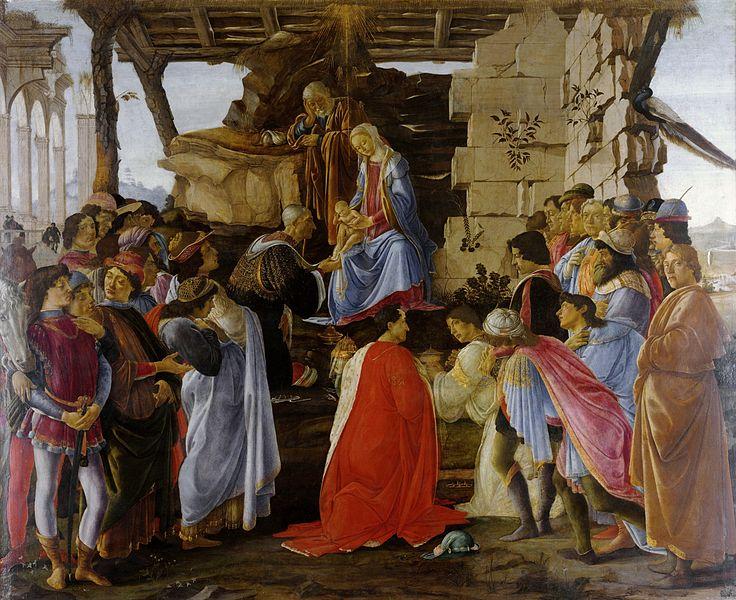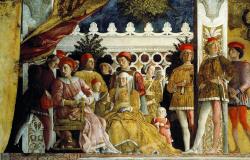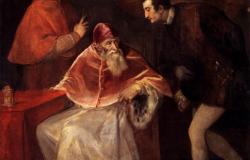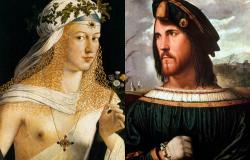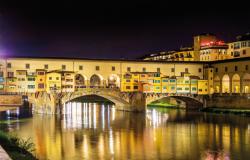Image above: The Adoration of the Magi, by Sandro Botticelli, portrays several members of the Medici family (housed in the Uffizi of Florence).
In our series featuring famous Italian families, Carol King looks at perhaps the most famous of them all: the Medici.
Pioneers of banking, patrons of the arts and backers of groundbreaking scientist Galileo Galilei, the Medici family left their mark on Italian life in numerous ways. They used their considerable wealth, power and influence to inspire the Italian Renaissance. Without their intelligence, taste, ambition, diplomacy and passion, the world would be deprived of some of its greatest works of art and architecture.
Why are they famous?
The Medici family ruled Florence and later Tuscany from the 15th to 18th centuries. Four members of the dynasty became popes: Leo X, Clement VII, Pius IV and Leon XI. A bourgeois family made good, the Medici married into the royal families of Europe, most famously in France in the shape of two queens, Catherine de’ Medici and Marie de’ Medici. Through their patronage of the arts, the Medici had a profound influence on Italian intellectual life. They advocated humanism, supported scientific enquiry, and encouraged artists and architects to flourish.
Who’s who?
Giovanni di Bicci de’ Medici
Giovanni di Bicci de’ Medici (1360-1429) is regarded as the first of the great Medici. He inherited the family textile-manufacturing business and founded the Medici Bank, which, at its prime, was the largest and most respected financial institution in Europe. Thanks to Giovanni’s business acumen, the Medici rose to power in Florence and later became the wealthiest family in Europe.
Cosimo de’ Medici, Cosimo the Elder
Giovanni di Bicci de’ Medici’s son, Cosimo the Elder (1389-1464), was the man to put the family on the map as a political dynasty by becoming the de facto ruler of Florence. Although he did not hold public office, even the pope at the time recognised that matters of state were settled within the walls of Cosimo’s home. King in all but name, Cosimo decided on war and peace, helping maintain a balance of power between the northern Italian states. He patronised some of Italy’s best artists of the time including Donatello and Fra Lippi. Cosimo also bankrolled the architect Filippo Brunelleschi so he could complete the dome of Florence’s cathedral, the Basilica di Santa Maria del Fiore.
 Lorenzo de’ Medici, Lorenzo the Magnificent
Lorenzo de’ Medici, Lorenzo the Magnificent
Cosimo the Elder’s grandson, Lorenzo de’ Medici (1449-92) combined two roles: running the Medici Bank and leading the Florentine Republic. He was one of the wealthiest men in Europe. Lorenzo spent his money wisely, as a philanthropist, art collector and patron of the arts. He was known as “Il Magnifico” (The Magnificent), perhaps partly because he was lucky enough to have the knack of sponsoring genius: he was the patron of Leonardo da Vinci, Sandro Botticelli and Michelangelo. His diplomatic efforts helped keep other European states out of Italy.
Giovanni de’ Medici, Pope Leo X
Lorenzo the Magnificent’s second son, Giovanni de’ Medici (1475-1521), was groomed for a life in the Church as a child. He became the youngest cardinal in history aged 13 years old. His papacy was marked by lavish spending that drove the Vatican to near ruin as he emptied its coffers. Charitable with a love of culture, be it literature or art, as Pope Leo X he spent money on hospitals, universities, churches and, notably, St. Peter’s Basilica. His love of the good life and willingness to sell ecclesiastical positions for money grated with many, and his pontificate witnessed the birth of the Protestant Reformation.
Giulio di Giuliano de’ Medici, Pope Clement VII
Giulio di Giuliano de’ Medici (1478-1535) was the illegitimate son of Lorenzo the Magnificent’s brother, Giuliano. A grieving Lorenzo adopted Giulio because his brother and Giulio’s father, Giuliano, was assassinated a month before Giulio’s birth. Giulio grew up with his cousins and entered the Church, becoming a fixer for his cousin Pope Leo X. After Leo’s death and the brief pontificate of Pope Adrian VI, Giulio was elected pope, taking the name Clement VII. As pope, he had a tough time: he faced King Henry VIII’s demands for divorce that led to England’s break up with the Catholic Church, the rise of Protestant reformer Martin Luther and the threat of invasion by France. Things reached a low in 1527, when Clement had to take refuge in the Castel Sant’Angelo during the Sack of Rome that destroyed the city. He remained imprisoned in the castle for months until he managed to escape dressed as servant. When peace was re-established, the Vatican was weakened and Clement followed a policy of subservience to the Holy Roman Emperor, Charles V. Clement’s greatest legacy came at the end of his life, when, only a few days before he died, he commissioned Michelangelo to paint ‘The Last Judgment’ for the Sistine Chapel.
 Catherine de’ Medici, Queen of France
Catherine de’ Medici, Queen of France
Pope Clement VII married off his cousin Catherine de’ Medici (1519-89) to the son of King Francis I of France, the future King Henry II. It was a union of convenience to shore up the pope’s relations with the French crown. As Henry’s wife, Catherine ruled France as queen from 1547 until 1559 but only in name. She had a difficult marriage because Henry excluded her from participating in the affairs of state, rather he elevated his mistress Diane de Poitiers, upon whom he showered his affection openly, giving her power, property, wealth and gifts. However, Catherine had her revenge when Henry died by banishing Diane from court. Catherine went on to have considerable political influence, even serving as regent, because all three of her sons became kings. She became one of the most powerful women in Europe. Catherine was a champion of the arts and oversaw the late blossoming of the French Renaissance by embarking on a programme of building projects, introducing what came to be recognised as the first-ever ballet at the French court, and becoming patron to a raft of artists, performers and writers.
Cosimo de’ Medici, Cosimo I, Grand Duke of Tuscany
The great-great-grandson of Lorenzo the Magnificent, Cosimo (1519-74) restored the Medici family to power as rulers of Florence. Cosimo was recognised as ruler of the Florentine state by the Holy Roman Emperor, Charles V, after aiding him against the French. A military man, Cosimo also defeated the Sienese and Pope Pius V created him Cosimo I, Grand Duke of Tuscany, as a reward. Like his ancestors, Cosimo was a great patron of the arts, including leading names such as artist, architect, and biographer Giorgio Vasari, and sculptor and goldsmith Benvenuto Cellini. Cosimo left behind a significant legacy, being responsible for the creation of Florence’s Pitti Palace, the Boboli Gardens and the Uffizi.
